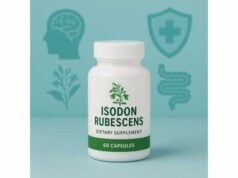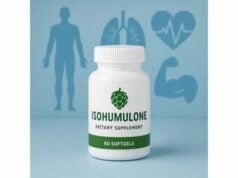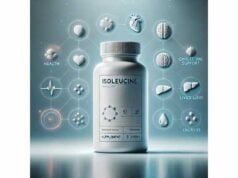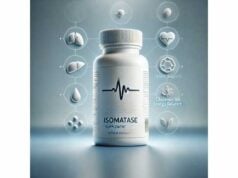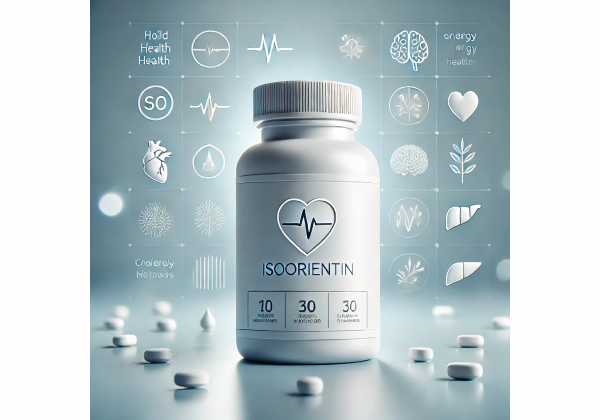
Isoorientin is a plant-derived flavone (specifically luteolin-6-C-glucoside) found in rooibos tea, passionflower, bamboo leaves, and certain grains. In cells and animal models, it shows antioxidant, anti-inflammatory, and mitochondrial-supportive effects—mechanisms that may underlie promising findings for skin health, metabolic balance, and recovery from tissue injury. While human data are still limited, isoorientin’s safety profile appears favorable within food-level intakes, and topical use is being explored for photoprotection and wound care. This guide translates the science into practical, people-first advice: what isoorientin is, what it may do, how to use it sensibly, and who should avoid it. You’ll find clear ranges for supplemental and topical use, smart pairing ideas, and realistic expectations based on the current evidence—so you can decide whether isoorientin belongs in your routine.
Quick Facts
- May support mitochondrial function and healthy oxidative balance, with early signals for skin and metabolic health.
- Animal and cell studies dominate; human evidence is emerging and not yet definitive.
- Typical supplemental range: 50–200 mg/day isoorientin (or extracts standardized to deliver this); topical 0.1–2.5% in experimental formulas.
- Avoid if you’re pregnant, breastfeeding, or on anticoagulants unless a clinician approves.
Table of Contents
- What is isoorientin and why it matters
- What are the most studied benefits?
- How to use it: forms, timing, and practical tips
- Absorption, pairings, and who it suits
- Safety, side effects, and who should avoid
- Evidence snapshot and research gaps
What is isoorientin and why it matters
Isoorientin is a naturally occurring C-glycosylated flavone—chemically, luteolin-6-C-glucoside. “C-glycosylated” means the sugar is attached to the flavone backbone via a carbon–carbon bond rather than the more common oxygen link. That unusual bond makes isoorientin more resistant to breakdown during digestion and processing, which can influence how it’s absorbed, metabolized, and ultimately acts in the body. Plants synthesize isoorientin as part of their defense system; in people, it behaves mainly as an antioxidant and inflammation modulator.
You’ll find isoorientin in:
- Beverages and herbs: Rooibos tea (both red/fermented and green/unfermented), passionflower (Passiflora), bamboo leaf infusions.
- Foods: Certain grains (e.g., millet, buckwheat) and some fruits, though amounts vary widely by cultivar and processing.
- Topicals and supplements: Cosmetic serums or creams exploring photoprotection and skin repair, and capsules standardized for C-glycoside flavones.
Mechanistically, isoorientin’s pharmacology spans several complementary actions:
- Redox balance: It scavenges reactive oxygen species, supports endogenous antioxidant enzymes (e.g., superoxide dismutase, glutathione-related pathways), and helps protect cellular structures—mitochondria in particular—under stress.
- Inflammation modulation: It can temper upstream signaling (such as JNK activity) that otherwise amplifies inflammatory cascades.
- Mitochondrial support: By improving respiratory chain activity and biogenesis markers in preclinical models, it may help cells produce energy more efficiently after stress.
- Skin defense and repair: Early in vivo work suggests topical isoorientin can mitigate UVB damage and may promote orderly tissue repair after injury.
Compared with related flavonoids (like orientin, vitexin, and isovitexin), isoorientin’s di-hydroxy pattern on the luteolin core tends to confer stronger antioxidant potency in model systems. C-glycosylation can also alter how enzymes process it: some metabolism studies show partial cleavage to luteolin derivatives alongside conjugation (e.g., glucuronides, sulfates), which likely affects bioavailability and tissue distribution.
Bottom line: isoorientin is a distinctive flavone with multifaceted cellular effects. Those properties—especially redox control and mitochondrial support—explain why it’s being studied for skin resilience, metabolic health, and recovery from localized injury.
What are the most studied benefits?
1) Skin protection and recovery
The skin is constantly challenged by ultraviolet radiation and environmental stressors. In preclinical studies, isoorientin applied to UVB-exposed skin dampened oxidative stress, reduced matrix-degrading enzymes (MMP-1/3), and promoted protective autophagy while curbing pro-aging signaling. Separate animal work has examined topical isoorientin in excisional wounds, observing faster closure and more organized tissue architecture—likely via early-phase inflammatory modulation and antioxidant activity. Practically, these findings support exploring isoorientin in daytime photoprotection serums and after-sun repair balms, especially as part of a formula with UV filters or DNA-repair/antioxidant companions. Do note that these are preclinical results; human skin outcome trials are still needed.
2) Mitochondrial and metabolic support
Skeletal muscle and metabolic tissues rely on efficient mitochondrial function. In cell systems mimicking mitochondrial stress (e.g., antimycin A exposure), isoorientin improved oxygen consumption, ATP metrics, and expression of biogenesis-related genes (such as NRF1, TFAM, and SIRT1 surrogates in the models), while lowering ROS. Mechanistically, this dual action—better bioenergetics with less oxidative burden—is consistent with subjective reports of improved exercise tolerance or metabolic “steadiness” when such flavonoids are consumed through diet (e.g., rooibos). Translation to clinical endpoints like HbA1c, fasting glucose, or VO₂max requires controlled human trials, but the direction of effect is biologically plausible.
3) Cardiometabolic context via rooibos
Rooibos tea naturally contains isoorientin along with aspalathin and orientin. Human interventions with rooibos—though modest and heterogeneous—have reported improvements in antioxidant status and aspects of lipid or glucose handling in certain populations. Because whole-tea outcomes cannot be attributed to isoorientin alone, it’s best to treat rooibos as a food-based delivery for a portfolio of synergistic flavonoids, with isoorientin contributing to the overall effect.
4) Cellular resilience under oxidative load
Across multiple cell types, isoorientin reduces ROS and supports survival signaling during chemical or mechanical stress. In tissues prone to high oxidative flux (skin exposed to UV, metabolically active muscle, wounded tissue), these actions can translate into less structural damage and smoother recovery trajectories in preclinical models. That makes isoorientin attractive as an “adjacent” support rather than a stand-alone treatment for disease.
What this means for you
- For skin, isoorientin looks most compelling when combined with proven UV filters and barrier-supportive lipids.
- For metabolic wellness, consider food-based intake (rooibos) first; supplements can be a second step if you’re targeting specific doses or can’t meet intake from diet.
- Expectations should stay grounded: benefits are more about supporting cellular conditions than delivering a drug-like effect.
How to use it: forms, timing, and practical tips
Dietary route
- Rooibos tea: 1–3 cups/day is a simple, low-cost way to introduce isoorientin alongside companion flavonoids. Green (unfermented) rooibos generally contains higher flavonoid levels than red, but both are reasonable. Brew 5–10 minutes to maximize extraction; longer steeps deepen flavonoid yield without adding caffeine (rooibos is naturally caffeine-free).
Supplement route
- Capsules or powders: Choose products standardized to isoorientin content or total C-glycosylated flavones. Because human dosing is not established, a conservative starting range is 50–200 mg/day of isoorientin, or an extract that reliably delivers a similar amount. Many multi-flavonoid complexes supply isoorientin alongside orientin/vitexin; in that case, follow the label and treat the lower end of the range as your starting point.
- When to take: With meals to align with intestinal transporters and reduce any GI upset. Splitting the total into two doses (morning and evening) can smooth plasma exposure.
Topical route
- Serums/creams: Experimental and cosmetic formulas often use 0.1–2.5% isoorientin, sometimes in liposomes or with penetration enhancers. For photoprotection, apply in the AM under sunscreen; for repair, apply PM after cleansing. Patch-test new products on the inner forearm for 24–48 hours.
- Stacks that make sense: Niacinamide for barrier and redness, vitamin E for lipid-phase antioxidant synergy, panthenol or madecassoside for repair, and broad-spectrum SPF for daytime.
How long to try
- Skin: Expect texture and tone support in 4–8 weeks with daily use, and post-procedure soothing within days when used as an adjunct (per practitioner guidance).
- Metabolic/lifestyle: With diet plus tea or supplements, reassess energy steadiness or training recovery after 6–12 weeks. Track objective markers (steps, RPE in workouts, fasting glucose if you already monitor).
Storage and quality
- Store supplements in a cool, dry place away from light.
- Look for third-party testing (identity, potency, heavy metals, microbes).
- For topicals, airless pumps or opaque tubes help preserve potency.
Absorption, pairings, and who it suits
Absorption and metabolism 101
C-glycosides like isoorientin aren’t handled exactly like typical (O-glycosylated) flavonoids. In intestinal models, they undergo phase II conjugation (glucuronidation, sulfation) and—surprisingly—can experience partial C–C bond cleavage that yields luteolin-type conjugates. Practically, that means:
- Meal timing helps. Taking isoorientin with food, especially a mixed meal containing modest fat, can improve micellar solubilization and intestinal uptake of accompanying lipophilic cofactors in blended formulas.
- Steady intake may matter. Because conjugated metabolites circulate and recirculate, consistent daily use likely matters more than chasing a single “peak” dose.
Smart pairings
- Vitamin C (food or supplement): Supports redox cycling and may help regenerate oxidized flavonoids.
- CoQ10 or PQQ (if budget allows): For users targeting mitochondrial resilience in training blocks, these combos are mechanistically coherent, though formal synergy trials are limited.
- Rooibos + exercise: In active individuals, pairing rooibos intake with training may enhance subjective recovery in some contexts; hydrate adequately.
Who is isoorientin a good fit for?
- Skin-forward users looking to round out antioxidant defenses under sunscreen.
- Tea drinkers wanting a caffeine-free, low-tannin option with a polyphenol profile different from green/black tea.
- Nutrition tinkerers exploring gentle, food-based strategies for oxidative balance during high-stress periods.
Who may not benefit as much
- Users expecting drug-like, rapid changes in metabolic labs without broader lifestyle support.
- Individuals already on comprehensive antioxidant regimens who notice no incremental changes from adding another polyphenol—simplicity has value.
Safety, side effects, and who should avoid
What we know so far
- Dietary amounts (e.g., from rooibos tea) appear well tolerated in adults.
- Supplemental isoorientin has limited human safety datasets; however, its parent foods and companion flavonoids are broadly consumed without major signals when used reasonably.
- Topical use is generally low-risk; rare users may experience mild irritation, especially with higher concentrations or penetration enhancers.
Potential side effects
- Gastrointestinal: Nausea or a “heavy stomach” feel when taken on an empty stomach. Minimize by taking with meals and starting low.
- Headache or lightheadedness: Uncommon; may reflect individual sensitivity or stacking with multiple redox-active compounds.
- Skin irritation: More likely with concentrated serums or leave-on peels that also include acids or retinoids.
Medication and condition cautions
- Anticoagulants/antiplatelets: Flavonoids can, in theory, affect platelet function or drug metabolism; discuss with your clinician if you use warfarin, DOACs, or dual antiplatelet therapy.
- Chemotherapy or immunotherapy: Always coordinate with oncology teams before adding antioxidant supplements.
- Pregnancy and breastfeeding: Safety data are insufficient; avoid supplemental isoorientin unless a clinician explicitly recommends it.
- Allergy history to source plants: If you react to passionflower or unique herbal components, patch-test topical products and introduce oral forms cautiously.
Stop and seek advice if you notice
- Persistent GI distress, rash, hives, facial swelling, wheeze, or any sign of hypersensitivity.
- Unexplained bruising or bleeding (especially if on blood thinners).
Practical safety framework
- Favor food-first approaches (rooibos, mixed diets) unless there’s a specific reason to supplement.
- If supplementing, start at the low end (e.g., 50 mg isoorientin daily for 1–2 weeks) and titrate only if needed.
- For skincare, patch-test and pair with sunscreen; antioxidants are complements, not replacements, for UV filters.
Evidence snapshot and research gaps
What’s strongest today
- Cutaneous models: Isoorientin mitigates UVB-induced damage pathways in vitro and improves tissue organization and closure in mouse wound models. Collectively, these align with user-visible outcomes (calmer skin after stress, better cosmetic healing) but require human confirmation.
- Mitochondrial metrics in muscle cells: Under acute stress, isoorientin enhances respiration and biogenesis markers and lowers ROS, suggesting a role in cellular resilience.
- Metabolic plausibility: As part of rooibos and other plant matrices, isoorientin co-travels with flavonoids that have cardiometabolic signals in early human work, though attribution to isoorientin alone is not possible.
What’s promising but preliminary
- Glucose and lipid handling: Animal studies and tea-based human data suggest potential, but dose-response and isolated isoorientin trials in people are lacking.
- Pharmacokinetics in humans: We need time-course profiles (parent vs. conjugates), tissue distribution, and food-matrix effects.
- Topical human RCTs: Split-face or controlled photoprovocation studies could clarify real-world effect sizes on erythema, pigmentation, and recovery.
What to watch next
- Standardized extracts: Better labeling and third-party verification of isoorientin content will enable consistent research and consumer decisions.
- Combination studies: Head-to-head comparisons with orientin, vitexin, and isovitexin, plus synergistic stacks (niacinamide, vitamin C/E, ferulic), to map complementary benefits.
- Clinical populations: Trials in photoexposed workers, athletes in heavy training blocks, or people with impaired wound healing could reveal niche benefits.
How to apply the current evidence
- Treat isoorientin as supportive nutrition and skincare—not a stand-alone therapy.
- Favor steady, moderate intake and smart stacking over megadosing.
- Track outcomes that matter to you: skin comfort under sun exposure (with sunscreen), recovery quality, or daily energy steadiness. If nothing changes after a fair trial window, simplify your routine.
References
- Isoorientin alleviates UVB-induced skin injury by regulating mitochondrial ROS and cellular autophagy 2019 (Preclinical)
- Isoorientin Improves Excisional Skin Wound Healing in Mice 2024 (Preclinical)
- In Vitro Metabolism of Six C-Glycosidic Flavonoids from Passiflora incarnata L 2021 (Mechanistic)
- Rooibos Flavonoids, Aspalathin, Isoorientin, and Orientin Ameliorate Antimycin A-Induced Mitochondrial Dysfunction by Improving Mitochondrial Bioenergetics in Cultured Skeletal Muscle Cells 2021 (Preclinical)
- Isoorientin: A dietary flavone with the potential to ameliorate diverse metabolic complications 2020 (Review)
Disclaimer
This article is for educational purposes only and does not provide medical advice. Isoorientin and other supplements are not intended to diagnose, treat, cure, or prevent any disease. Always consult a qualified healthcare professional before starting, stopping, or combining any supplement—especially if you are pregnant, breastfeeding, have a medical condition, or take prescription medications.
If you found this helpful, consider sharing it with a friend on Facebook, X (formerly Twitter), or your favorite platform, and follow us for future updates. Your support helps us keep creating clear, evidence-informed guides.

